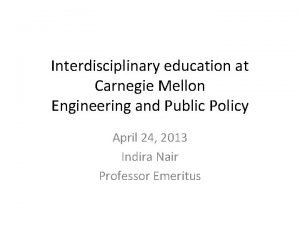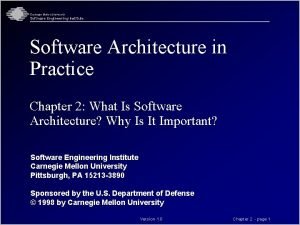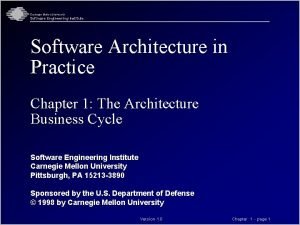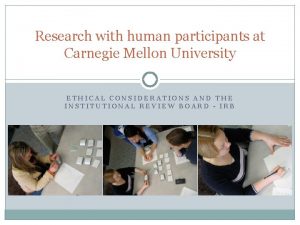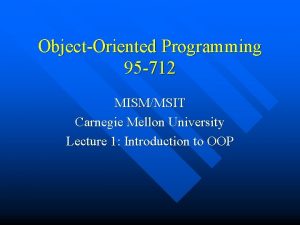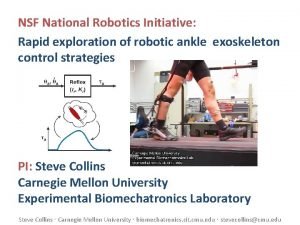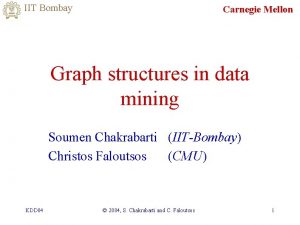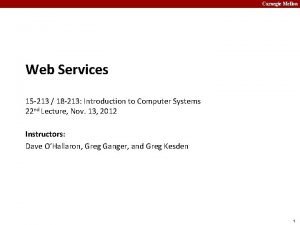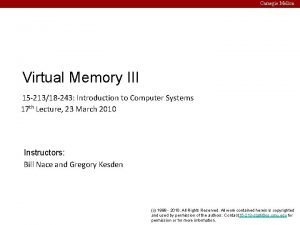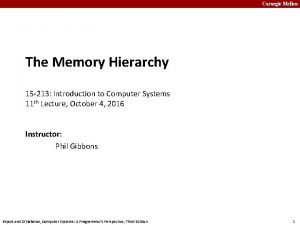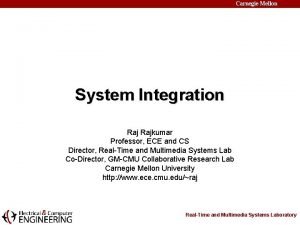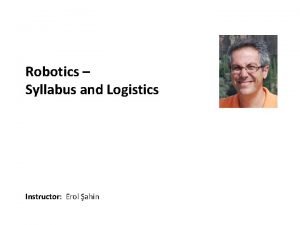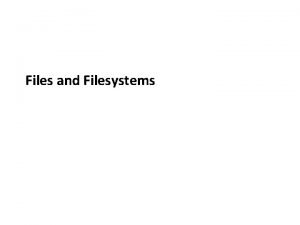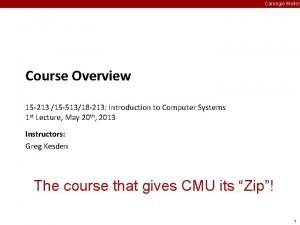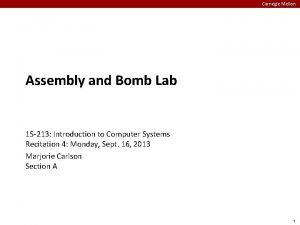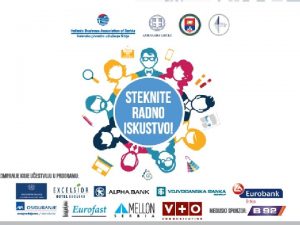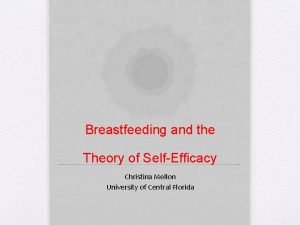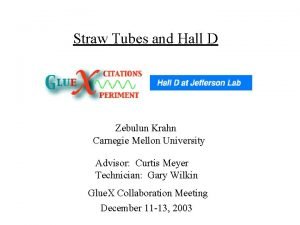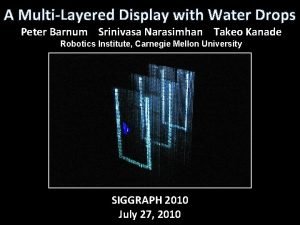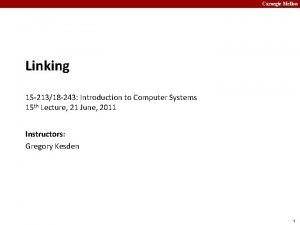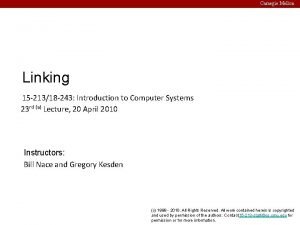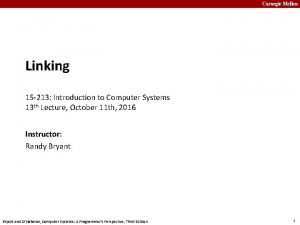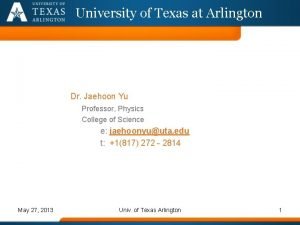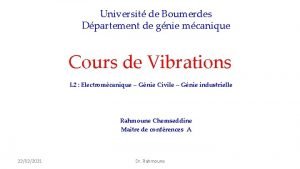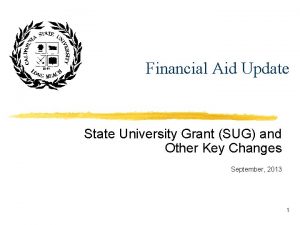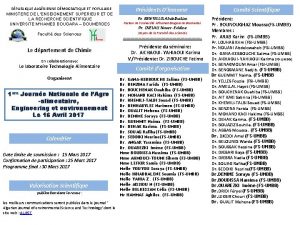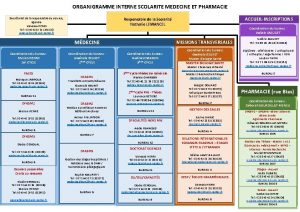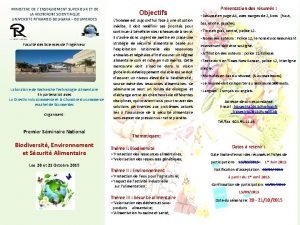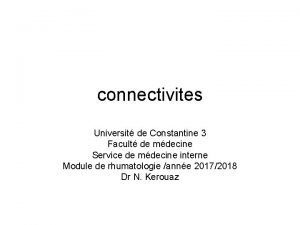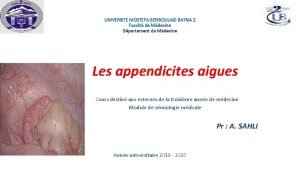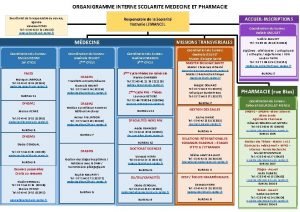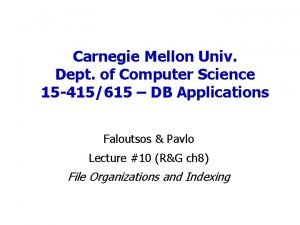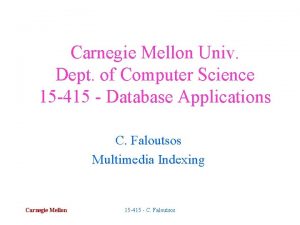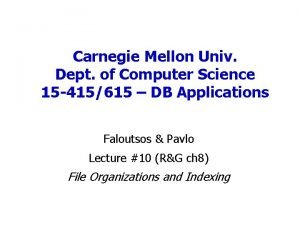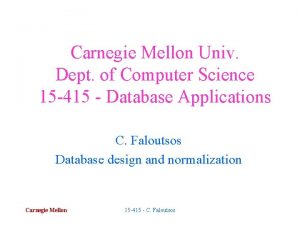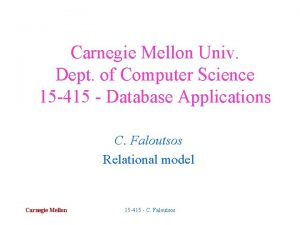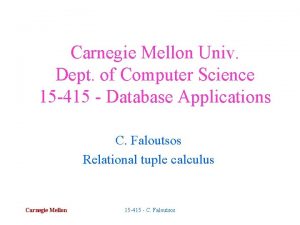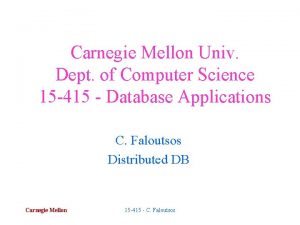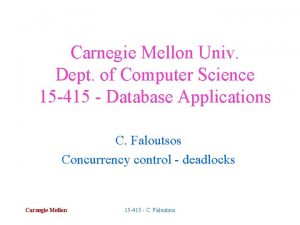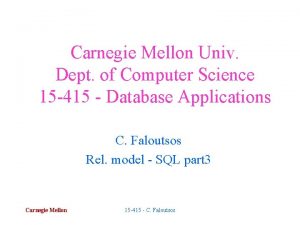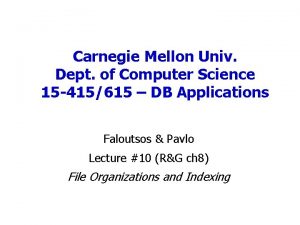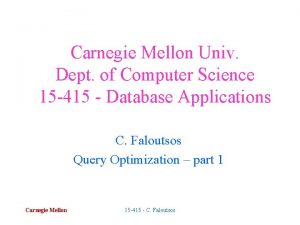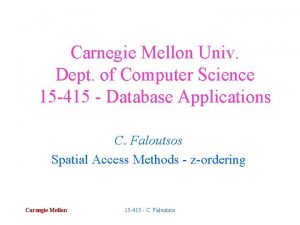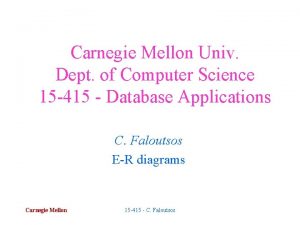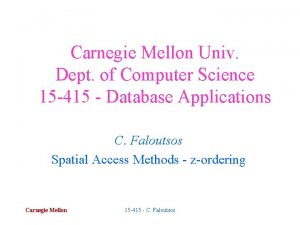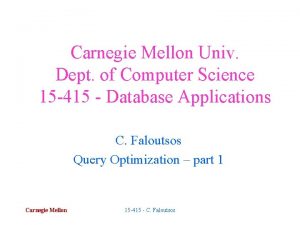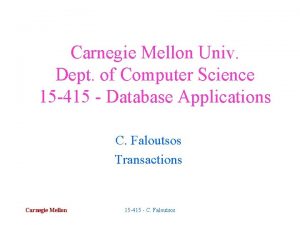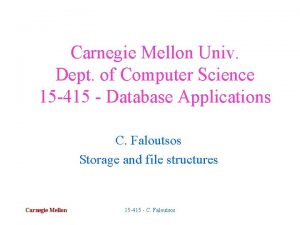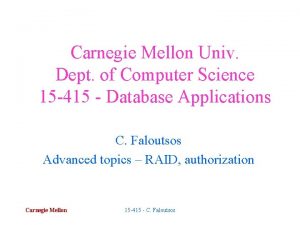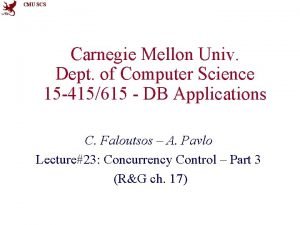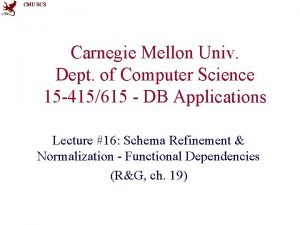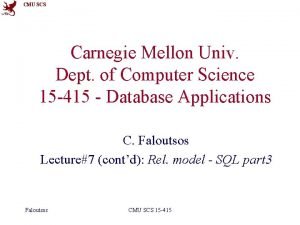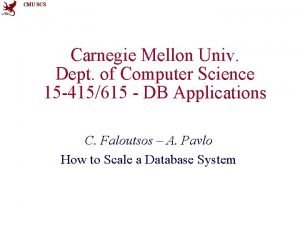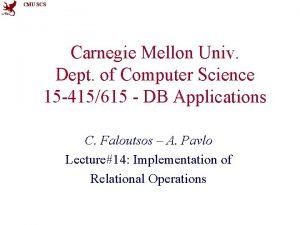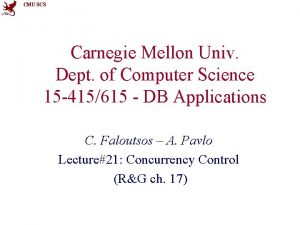Carnegie Mellon Univ Dept of Computer Science 15






























![Generalization/Special. no super-entity: [STUDENT(ssn, name, address)] PT-STUDENT( ssn, num-credits FT-STUDENT( ssn, major Carnegie Mellon Generalization/Special. no super-entity: [STUDENT(ssn, name, address)] PT-STUDENT( ssn, num-credits FT-STUDENT( ssn, major Carnegie Mellon](https://slidetodoc.com/presentation_image_h/f65e6d3f7a1ee24f22cf47329d9963aa/image-31.jpg)
![Generalization/Special. no super-entity: [STUDENT(ssn, name, address)] PT-STUDENT( ssn, num-credits, name, address) FT-STUDENT( ssn, major, Generalization/Special. no super-entity: [STUDENT(ssn, name, address)] PT-STUDENT( ssn, num-credits, name, address) FT-STUDENT( ssn, major,](https://slidetodoc.com/presentation_image_h/f65e6d3f7a1ee24f22cf47329d9963aa/image-32.jpg)






- Slides: 38

Carnegie Mellon Univ. Dept. of Computer Science 15 -415 - Database Applications C. Faloutsos E-R diagrams Carnegie Mellon 15 -415 - C. Faloutsos

Overview • concepts – Entities – Relationships – Attributes – Specialization/Generalization – Aggregation • turning E-R diagrams to tables Carnegie Mellon 15 -415 - C. Faloutsos 2

Tools Entitie s (‘entity sets’) N M P Relationships (‘rel. sets’) and mapping constraints attributes Carnegie Mellon 15 -415 - C. Faloutsos 3

Example Students, taking courses, offered by instructors; a course may have multiple sections; one instructor per course nouns -> entity sets verbs -> relationships Carnegie Mellon 15 -415 - C. Faloutsos 4

. . . name STUDENT ssn issn INSTRUCTOR Carnegie Mellon 15 -415 - C. Faloutsos 5

. . . name STUDENT c-id ssn c-name COURSE issn INSTRUCTOR but: sections of course (with different instructors)? Carnegie Mellon 15 -415 - C. Faloutsos 6

ssn STUDENT c-id SECTION s-id issn INSTRUCTOR Carnegie Mellon 15 -415 - C. Faloutsos COURSE but: s-id is not unique. . . 7

ssn STUDENT N takes M s-id issn c-id COURSE SECTION INSTRUCTOR Carnegie Mellon 15 -415 - C. Faloutsos 8

STUDENT N takes c-id M s-id SECTION COURSE N teaches 1 INSTRUCTOR Carnegie Mellon 15 -415 - C. Faloutsos 9

Cardinalities • 1 to 1 (example? ) • 1 to N • N to M Carnegie Mellon 15 -415 - C. Faloutsos 10

STUDENT N c-id takes M s-id SECTION N has 1 COURSE N teaches 1 INSTRUCTOR Carnegie Mellon 15 -415 - C. Faloutsos 11

More details • ‘weak’ entities: if they need to borrow a unique id from a ‘strong entity - DOUBLE box. • ‘c-id’ + ‘s-id’: unique id for SECTION • discriminator (eg. , ‘s-id’) c-id s-id Carnegie Mellon SECTION N has 15 -415 - C. Faloutsos 1 COURSE 12

More details • self-relationships - example? Carnegie Mellon 15 -415 - C. Faloutsos 13

manages 1 EMPLOYEE Carnegie Mellon N 15 -415 - C. Faloutsos 14

More details • 3 -way and k-way relationships? N EMPLOYEE M TOOL uses P PROJECT Carnegie Mellon 15 -415 - C. Faloutsos 15

More details - attributes • • candidate key (eg. , ssn; employee#) primary key (a cand. key, chosen by DBA) superkey (eg. , (ssn, address) ) multivalued or set-valued attributes (eg. , ‘dependents’ for EMPLOYEE) • derived attributes (eg. , 15% tip) Carnegie Mellon 15 -415 - C. Faloutsos 16

More details: • in the text: (eg. , ‘total participation’) SECTION 0: N teaches 1: 1 INSTRUCTOR Carnegie Mellon 15 -415 - C. Faloutsos 17

Overview • concepts – Entities – Relationships – Attributes – Specialization/Generalization – Aggregation • turning E-R diagrams to tables Carnegie Mellon 15 -415 - C. Faloutsos 18

Specialization • eg. , students: part time (#credithours) and full time (major) name ssn STUDENT IS-A major Carnegie Mellon FT-STUDENT 15 -415 - C. Faloutsos PT-STUDENT #credits 19

Observations • Generalization: exact reverse of ‘specialization’ • attribute inheritance • could have many levels of an IS-A hierarchy Carnegie Mellon 15 -415 - C. Faloutsos 20

Aggregation • treat a relationship as an entity • rarely used N CPU Carnegie Mellon M HD 15 -415 - C. Faloutsos MAKER 21

Overview • concepts – Entities – Relationships – Attributes – Specialization/Generalization – Aggregation • turning E-R diagrams to tables Carnegie Mellon 15 -415 - C. Faloutsos 22

STUDENT N grade M s-id c-id takes SECTION N has 1 COURSE N teaches 1 INSTRUCTOR Carnegie Mellon 15 -415 - C. Faloutsos 23

Strong entities just list the attributes, and underline the primary key, eg. STUDENT(ssn, name, address) Carnegie Mellon 15 -415 - C. Faloutsos 24

Multivalued attributes Eg. , EMPLOYEE with many dependents: • a new table, with (ssn, dependent-name) Carnegie Mellon 15 -415 - C. Faloutsos 25

Relationships • get primary keys all involved entities • primary key - depends on cardinality – 1 to 1: either eg EMPLOYEE( ssn, empno, name, . . . ) – 1 to N: the key of the ‘N’ part eg. TEACHES( issn, c-id, s-id) – N to M: both keys - eg TAKES( ssn, c-id, s-id, grade) Carnegie Mellon 15 -415 - C. Faloutsos 26

Relationships • 1 to N: no need for separate table - eg. , SECTION( issn, room-num, c-id, s-id) instead of SECTION 1(c-id, s-id, room-num) TEACHES(issn, c-id, s-id) • for rel. between strong and corresponding weak entity, no need for table, at all! Carnegie Mellon 15 -415 - C. Faloutsos 27

Generalization/Spec. Two solutions: - one table for each or - no table for super-entity (pros and cons? ) Carnegie Mellon 15 -415 - C. Faloutsos 28

Generalization/Special. Eg. , STUDENT(ssn, name, address) PT-STUDENT( FT-STUDENT( Carnegie Mellon 15 -415 - C. Faloutsos 29

Generalization/Special. Eg. , STUDENT(ssn, name, address) PT-STUDENT( ssn, num-credits) FT-STUDENT( ssn, major) Carnegie Mellon 15 -415 - C. Faloutsos 30
![GeneralizationSpecial no superentity STUDENTssn name address PTSTUDENT ssn numcredits FTSTUDENT ssn major Carnegie Mellon Generalization/Special. no super-entity: [STUDENT(ssn, name, address)] PT-STUDENT( ssn, num-credits FT-STUDENT( ssn, major Carnegie Mellon](https://slidetodoc.com/presentation_image_h/f65e6d3f7a1ee24f22cf47329d9963aa/image-31.jpg)
Generalization/Special. no super-entity: [STUDENT(ssn, name, address)] PT-STUDENT( ssn, num-credits FT-STUDENT( ssn, major Carnegie Mellon 15 -415 - C. Faloutsos 31
![GeneralizationSpecial no superentity STUDENTssn name address PTSTUDENT ssn numcredits name address FTSTUDENT ssn major Generalization/Special. no super-entity: [STUDENT(ssn, name, address)] PT-STUDENT( ssn, num-credits, name, address) FT-STUDENT( ssn, major,](https://slidetodoc.com/presentation_image_h/f65e6d3f7a1ee24f22cf47329d9963aa/image-32.jpg)
Generalization/Special. no super-entity: [STUDENT(ssn, name, address)] PT-STUDENT( ssn, num-credits, name, address) FT-STUDENT( ssn, major, name, address) Carnegie Mellon 15 -415 - C. Faloutsos 32

Aggregation • make table, with primary keys of all involved entities Carnegie Mellon 15 -415 - C. Faloutsos 33

Overview • concepts – Entities – Relationships – Attributes – Specialization/Generalization – Aggregation • turning E-R diagrams to tables Carnegie Mellon 15 -415 - C. Faloutsos 34

Summary • E-R Diagrams: a powerful, user-friendly tool for data modeling: – Entities (strong, weak) – Attributes (primary keys, discriminators, derived, multivalued) – Relationships (1: 1, 1: N, N: M; multi-way) – Generalization/Specialization; Aggregation Carnegie Mellon 15 -415 - C. Faloutsos 35

Summary - cont’d (strong) entity set attribute weak entity set multivalued attribute relationship set derived attribute identifying rel. set for weak entity Carnegie Mellon 15 -415 - C. Faloutsos 36

Summary - cont’d A primary key A discriminator IS-A total N M l: h l’: h’ cardinalities with limits Carnegie Mellon 15 -415 - C. Faloutsos generalization (e. t. c. - see book for alternative notations) 37

Conclusions • E-R Diagrams: a powerful, user-friendly tool for data modeling. Carnegie Mellon 15 -415 - C. Faloutsos 38
 Cmu comp bio
Cmu comp bio Carnegie mellon interdisciplinary
Carnegie mellon interdisciplinary Carnegie mellon software architecture
Carnegie mellon software architecture Bomb lab solutions
Bomb lab solutions Carnegie mellon software architecture
Carnegie mellon software architecture Carnegie mellon university research participants
Carnegie mellon university research participants Cmu mism
Cmu mism Randy pausch time management
Randy pausch time management National robotics initiative
National robotics initiative Carnegie mellon
Carnegie mellon 18-213 cmu
18-213 cmu Cmu vpn
Cmu vpn Carnegie mellon
Carnegie mellon Carnegie mellon
Carnegie mellon Carnegie mellon
Carnegie mellon Carnegie mellon
Carnegie mellon Carnegie mellon fat letter
Carnegie mellon fat letter Cmu 15-513
Cmu 15-513 Assembly bomb lab
Assembly bomb lab Mellon serbia iskustva
Mellon serbia iskustva Carneigh mellon
Carneigh mellon Christina mellon
Christina mellon Bny mellon health savings account
Bny mellon health savings account Zebulun krahn
Zebulun krahn Water mellon
Water mellon Mellon elf
Mellon elf Mellon elf
Mellon elf Mellon elf
Mellon elf My favorite subject is math
My favorite subject is math Ut arlington demographics
Ut arlington demographics Medecine dentaire constantine
Medecine dentaire constantine Ch rahmoune
Ch rahmoune State univ grant - sug ug
State univ grant - sug ug Fs boumerdes
Fs boumerdes Scolarité univ nantes
Scolarité univ nantes Fs.univ.umbb
Fs.univ.umbb Univ constantine 3
Univ constantine 3 Pharmacie univ batna 2
Pharmacie univ batna 2 Scolarité pharmacie nantes
Scolarité pharmacie nantes

